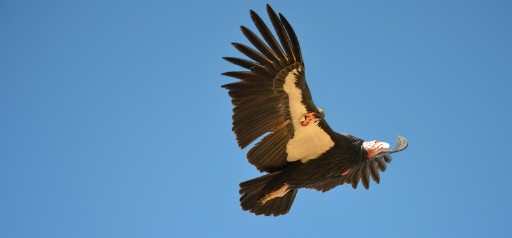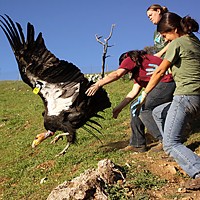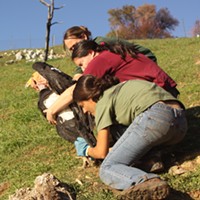News Blog

- Photo courtesy U.S. Fish and Wildlife Service
- California condor
The Yurok Tribe could be releasing some California condors into the wild somewhere along the lower reaches of the Klamath River within the next three years, according to the Associated Press and a news release from the Yurok Tribe (see below).
It's been about a century since the huge, ponderous condor — called Prey-go-neesh in Yurok — soared through these skies. It is an important being to the Yurok, as the tribe's news release notes:
"The condor was amongst the first animals to be placed here by the Creator. Various feathers, particularly the large wing feathers, are used to make ceremonial regalia, and feature heavily in Yurok world renewal ceremonies, like the Jump Dance and the White Deer Skin Dance. Feathers were collected opportunistically, as gifts from the birds, as the birds themselves were never to be harmed or killed."
The tribe's been researching reintroduction of the once-near-extinct bird for the past five years, in part by studying how its relative, the turkey vulture, inhabits the land, and also by looking at removing the barriers to its success as a species, such as poisoning from lead-bullet contamination in carcasses. Now the tribe has the go-ahead from the state and feds for "test releases."
You can read more about the tribe's launch on this journey in our previous coverage. And here's the Yurok Tribe's official news release:
YUROK TRIBE
190 Klamath Boulevard • Post Office Box 1027 • Klamath, CA 95548
FOR IMMEDIATE RELEASE
The Yurok Tribe recently signed an agreement making it possible to release California Condors back to the center of the endangered species’ historical range.
“Prey-go-neesh (California condor) is one of our most sacred animals,” said Yurok Tribe Chairman Thomas P. O’Rourke Sr. “We are working very hard to bring Prey-go-neesh back to our region.”
In addition to the Yurok Tribe, the Memorandum of Understanding was signed by the following: U.S. Fish and Wildlife Service, National Park Service, California Department of Parks and Recreation and the Ventana Wildlife Society.
“ The Yurok Tribe has put in the work and has what it takes to restore a self sustaining condor population,” said Kelly Sorenson, executive director of the Ventana Wildlife Society, a non-profit dedicated to wildlife and habitat conservation and 17 years of successful condor recovery work. “We fully support the Tribe’s effort and look forward to collaborating to once again have condors soaring over northern California and southern Oregon.”
For five years, the Yurok Tribe Wildlife Program studied critical aspects of condor habitat in Yurok Ancestral Territory. The Program, headed by Chris West, a veteran wildlife biologist and condor expert, is also developing a long-term management plan to ensure the successful reintroduction of North America’s largest bird. The Yurok release site will bolster overall condor recovery efforts, which until now have focused on Central and Southern California, Northern Arizona, and Baja Mexico.
“A self sustaining population of condors has a great chance of survival here. Yurok Ancestral Territory is relatively pristine and relatively few people. This is ideal for minimizing threats to the birds and really boosts the chances for successful reintroductions here,” said Yurok senior wildlife biologist, Chris West. “The redwood coast and interior oak grasslands have everything condors need, including ample, clean food resources and nesting opportunities.”
Once condors are released, the birds will likely remain close to the release area for a while, but as the flock grows, they will disperse across the landscape. Hopefully, Yurok Ancestral Territory will act as a gateway for condors back into their previous northern range of the entire Pacific Northwest. There have been no reported sightings of wild condors in the Pacific Northwest since about 1940, when a bird was seen near the city of Drain, Oregon. The last condor collected in the Pacific Northwest was shot in the 1890s in Kneeland, CA and is preserved in the Clarke Historical Museum in Eureka, CA.
The first European settlers killed great numbers of condors out of fear, just as they did the wolf and grizzly bear. Habitat loss, poisonings and shooting of birds further reduced condor numbers throughout the 1900s. By 1987, with only 22 birds left alive, the remaining wild birds were captured and put into a captive breeding program. In 1992, the first pair of condors was released into the wild. Today, there are 414 living birds with 232 of those outside of captivity in the southwestern United States.
The condor was amongst the first animals to be placed here by the Creator. Various feathers, particularly the large wing feathers, are used to make ceremonial regalia, and feature heavily in Yurok world renewal ceremonies, like the Jump Dance and the White Deer Skin Dance. Feathers were collected opportunistically, as gifts from the birds, as the birds themselves were never to be harmed or killed.
Yurok Ancestral Territory, located just south of the California/Oregon border, is the center of the historical condor range, which spanned from British Columbia to Baja California, Mexico. The area is home to some of the last remaining old-growth redwoods. When condors last lived in Yurok Country, the large raptors likely found ideal nesting in fire-formed tree cavities high above the ground, in old-growth redwoods. The strong beaked scavengers consumed the remains of land and sea mammals, like the deceased California sea lions that wash up on local beaches.
Once returned, condors will fill a currently unoccupied ecological niche as the only native bird species able to initiate, via its powerful bill, the biological breakdown of large mammals. The birds can tear through the tough hides of elk, bears, and even whales, bringing about the natural cycle of nutrients back into the ecosystem — turning death into life.
The Yurok Wildlife Program has extensively studied two primary factors limiting a successful, self-perpetuating
condor flock. The first is DDT, an organochlorine pesticide that was banned in the 1970s, but continues to contaminate the marine ecosystem, especially in southern California. The Yurok coastline has very little of the contaminant, which causes egg shell thinning and is accessed by condors that eat the blubber of seals and sea lions.
The second significant strain on the stability of wild condors is the availability of lead bullet fragments found in the remains of dead animals, often left in the field by poachers. Sampling more than 100 turkey vultures, a comparable surrogate for condors, the Tribe found that lead levels are lower in Yurok ancestral territory than levels published for any other location examined in historical condor range.
To further diminish the issues related to lead, the Tribe initiated the Hunters as Stewards campaign, which is based on the premise that hunters have a vested interest in wildlife conservation and, provided with accurate information, will make choices that benefit both wildlife and human health. For three years, tribal biologists have presented at numerous gun clubs and firearm shows to provide hunters with accurate information regarding the threats lead poses to humans and wildlife. Currently, there is a sea change occurring in the hunting community and everyday more and more people are switching to non-toxic ammunition for harvesting wild game.
While the condor’s nine and a half foot wingspan has not graced Yurok skies for more than a century, they remain a central part of the Tribe’s culture. Returning the California condor to the Pacific Northwest is part of the Yurok Tribe’s obligation to heal the world.
“We are very excited about the prospect of one day watching, as our ancestors did since time immemorial, condors glide over the Bald Hills or down the coastline,” concluded Yurok Tribe Chairman O’Rourke. The Yurok Tribe is the largest Tribe in California with nearly 6,000 members. The Tribe’s ancestral territory comprises 7.5 percent of the California coastline, spanning from the Little River to the south and Damnation Creek to the north. The northern boundary is the Klamath River’s confluence with the Trinity River. The Tribe is a leader in natural resource management, fisheries restoration and cultural protection.


Comments